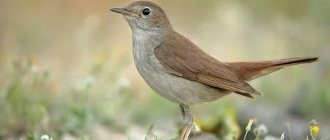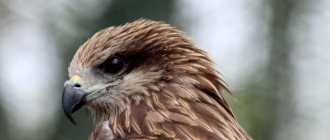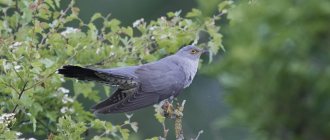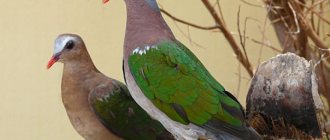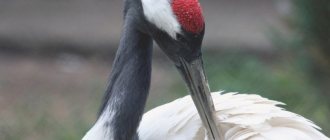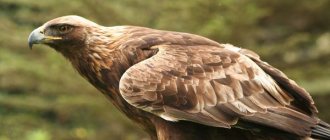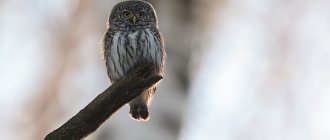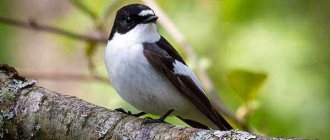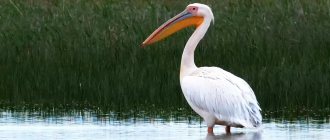More than half of the birds living on the planet are passerines. Nightingales also belong to this order. In Europe, the most common nightingale is the common nightingale. Latin name: Luscinia luscinia. This homely bird became a symbol of singing talent and turned into a glorified romantic image.
Common nightingale (Luscinia luscinia). Photo by: Svitlana Tkach
General description and zoological classification
Nightingales belong to the order Passeriformes, the family of flycatchers and thrushes. These animals are small in size: the body length is only 16–20 cm, and the maximum weight is 25 g. The wingspan is 24–27 cm, the tail feathers are elongated. The color of the common nightingale does not differ in the brightness of its colors; the color of the plumage varies from light brown to brownish-gray. The wings are darker than the sides and belly, the neat small beak is yellow. There is no obvious sexual dimorphism; the female and male eastern nightingale, for example, hardly differ in appearance, they are easy to confuse. But among representatives of all other species, males have brighter and more elegant colors. The range of nightingales is huge: almost all of Europe and Western Asia. The geography of travel is also extensive - nightingales spend the winter in the tropics of Africa.
Biological systematics
There are fourteen species of nightingales.
- Golden-tailed nightingale (Luscinia chrysaea),
- Indian nightingale (Luscinia brunnea),
- Blue nightingale (Luscinia cyanura),
- Red-breasted nightingale (Luscinia hyperythra),
- White-browed nightingale (Luscinia indica),
- Common or eastern nightingale (Luscinia luscinia),
- Taiwan nightingale (Luscinia johnstoniae),
- Ryukyu nightingale (Luscinia komadori),
- Rubythroat Nightingale (Lusciania calliope),
- Red-headed Nightingale or Red-headed Robin (Luscinia ruficeps),
- Bluethroat (Luscinia svecica),
- Southern or western nightingale (Luscinia megarhynchos),
- Black-throated Nightingale (Luscinia obscura),
- David's nightingale (Luscinia pectardens).
Let's talk in more detail about “Russian” nightingales - inhabitants of the Russian Federation and surrounding regions.
Common or eastern nightingale. It inhabits most of Europe: from the Yenisei and Altai in Siberia, to the North Caucasus and Crimea in the south. In the west, the range covers Poland and the Baltic states. The singing of these birds is sonorous and melodic. Western or southern nightingale. It is a close relative of the common nightingale. The plumage is reddish, the size is smaller than that of its neighbors from the East. They are found in Central and Southern Europe, western Ukraine and Asia Minor. Rubythroat nightingale. This bird is no larger than a sparrow. An interesting detail of the appearance of males is a patch of bright red plumage on the throat. Vocal abilities are not inferior to the singing talent of the eastern nightingale. Often the vocalization of the ruby-throated nightingale begins with onomatopoeia to the voices of other birds; its singing is expressive and sonorous, but does not last long. Representatives of the species live in the Far East and Siberia, and fly to India, China and Southeast Asia for the winter. Blue nightingale. It differs in color: the head, back and wings of males are gray-blue. They nest in the Far East, Eastern Siberia, China, Korea and Japan. The song of blue nightingales is beautiful and simple, consisting of whistles of varying duration and pitch. Bluethroat. The Russian version of the bird's name comes from the characteristic sound “varak-varak”, which is repeated in its singing. The Latin name Luscinia svecica is translated as “Swedish nightingale” in honor of the discoverer of the species, C. Linnaeus. The bluethroat lives throughout Russia, Northern Europe and Northern Asia. It has bright plumage. The throat of males is decorated with a multi-colored pattern: a blue spot with a bright red or white center. Below on the chest are black and brown arches in the shape of a necklace. Like many nightingales, bluethroats can imitate the singing of other birds. Their own melody is full of rapid chirps, whistles and clicks.
Bluethroat (Luscinia svecica). Photo by: Svetlana Golovanova
Nutrition
At night the nightingale trills, and during the day it looks for food . He rakes the leaves on the ground, takes out bugs, worms, caterpillars and other living creatures. The nightingale can even catch prey on the fly; it has enough dexterity for this. In the summer, various ripe berries and fruits appear in the nightingale's diet, and it is especially partial to elderberry. Closer to autumn, he begins to stock up on fat, since he has a long flight to winter.
The nightingale brings great benefits to nature, as it saves plants from death. Its menu consists mainly of insect pests that destroy trees by eating bark and leaves.
Habitat, reproduction, seasonal migrations
The nightingale's nesting sites are shrubs in lowlands, floodplains, and on the edges of forests. They prefer dense vegetation, shady secluded gardens, and abandoned summer cottages. Nightingales make nests on the ground in thickets of grass or roots of bushes, rarely on lower branches if the spring was wet with a late flood. The nest is shaped like a bowl, sometimes with a canopy, and is built from all available materials: fallen leaves, thin branches, straw. Future parents carefully line the inside of the nest with scraps of animal hair and camouflage it in thick grass. As a rule, the space around is covered with the remains of “building materials”. At the same time, nightingales are not as timid as, for example, their close relatives, robins. In search of food, nightingales move on the ground with dignity, carefully observe the surrounding space, and make long jumps. You can get quite close to them, especially when the nightingale is singing. Ornithologists are sure that at this moment the bird will not notice any extraneous sound.
Nightingales are divided into migratory and sedentary. Nightingales from hot countries lead a sedentary lifestyle and do not need to fly south with the change of season. They can feed themselves in their homeland. Migratory nightingales inhabit Europe, as well as Western and Northern Asia. These birds go to winter in India, China, Japan, Korea, Indonesia, and travel enormous distances to reach suitable climatic zones. Migratory nightingales return from wintering by mid-April. First, the males arrive, look for a nesting site, and wait for the females to return. Their songs during this period are heard only at night. But with the beginning of the mating season, everything changes: nightingales attract a partner by singing, their polyphonic choir sounds day and night. It is believed that females sing worse. They attract the attention of the male by whistling softly and jumping along the ground and branches. Nightingale “flirting” performed by males looks like a kind of gesticulation. They spread their tails, arch their backs, lower their feathers, and show off in every possible way in front of their friends.
When the honeymoon is over and the couple is formed, the songs noticeably subside. First of all, vocalization is needed to attract a partner. In June, the female lays 4 to 6 eggs. Only the mother does the incubation; the male gets her food. After two weeks, the chicks hatch and are fed by both parents. Just a few days later, the fledglings disperse around the nest, but remain under the supervision of adults. The natural enemies of nightingales in nature are snakes and birds of prey. The couple takes care of the offspring from two weeks to a month. By the beginning of autumn, nightingales gather south. They fly away to spend the winter alone, usually at night.
Common nightingale feeding chicks
Where does the nightingale live?
Nightingales have a wide range of habitats, but a significant concentration of these birds is present in England. Because of this, nightingales are sometimes called English birds. In this place, birds can be found almost anywhere where there is a sufficient amount of vegetation and bushes: in parks, forests, etc. In addition to England, birds live in different countries of the world. For example, in Russia, nightingales can also be seen almost everywhere.
In Iran, nightingales are considered a national symbol, repeatedly sung by local poets.
Nightingales choose to live in areas that are located in lowlands and are characterized by the presence of bushes, hedges and other vegetation. Typically these are areas that are located in river basins or close to other bodies of water. However, birds can also be seen on hills or in bushes that grow quite low, closer to the coastal dunes.
Throughout the day, nightingales constantly change location, which makes it possible for people to listen to their singing in different places. At the same time, night singing, as a rule, sounds from one place. The songs are separated by time periods of 2-3 hours. The first aria is usually performed before midnight, the second is performed closer to the morning.
The most common species, the common nightingale, is a typical migratory bird. Their habitat ranges from the western border of Russia all the way to the Yenisei. In the south, their area of residence runs through the Caucasus and Kazakhstan.
For nightingales, the preferred habitats are lowland mixed forests with high humidity.
They especially like oak forests, which are located in wetlands that run along water bodies. Nightingale nests are located in damp thickets, which are covered with shade from the sun. As a rule, thickets of elderberry or bird cherry are chosen for this.
Sometimes nightingales can be seen in urban areas in areas of public gardens and parks. Birds are attracted to areas with a lot of vegetation, close to lakes and ponds.
With the onset of winter, birds from the northern regions move to Saudi Arabia, northern and eastern Africa for the winter.
Diet and life expectancy
In the wild, nightingales live 8–10 years, in rare cases - 12. Despite its widespread distribution, the common nightingale is not the largest population and is a commercially endangered species. Nightingales are caught for collections and home keeping. This barbaric trend still exists. And in some developed countries of Europe and Asia they are even eaten.
Nightingales feed on insects, but in general these birds are omnivores. The basis of the diet is:
- beetles, caterpillars, slugs, spiders, land mollusks, worms, ant eggs;
- berries, plant seeds;
- nuts.
Nightingales are useful in agriculture. They destroy a huge number of harmful insects that damage crops and forest ecosystems.
Nightingale with an insect in its beak Photo credit: Big Al Strood
Natural enemies
Despite the fact that nightingales are good at camouflage and hunting, their small size often makes them potentially defenseless against danger in the form of predators. Thus, nightingales are usually hunted by foxes, snakes, cats, weasels, and ermine. Some large birds of prey are also capable of attacking nightingales, such as owls.
In addition, people also often become a source of potential problems for birds. They may admire the nightingale's singing and strive to tame the birds by imprisoning them in a cage. Nightingales do not tolerate captivity conditions well, and therefore often die in such circumstances. In addition, people are engaged in cutting down forests, which constitute the characteristic habitats of birds in the wild.
Despite the hunter's skills, such a small size of the nightingale often puts him in the face of danger. It can easily be caught by cats, rats, foxes, snakes and small predators such as ermine or weasel. Even large birds of prey do not disdain hunting nightingales.
Nightingales of East Asia and the Indomalayan zone
Golden-tailed nightingale . Lives in the Indo-Malayan region: India, Nepal, Myanmar, Pakistan, Bhutan, Tibet, Thailand, Vietnam. Favorite nesting places are wooded areas.
Indian nightingale . As the name suggests, these birds are native to India. Indian nightingales also live in several Asian countries. The appearance of the “Indians” is memorable, the plumage is bright, matching the surrounding nature. The tail, wings and head are blue, the chest and abdomen are yellow, and have large eyes. The vocalizations of these birds are pleasant to the human ear, but the melodies are simple and unpretentious.
Red-breasted nightingale . Reproduction of this species occurs in late spring in Nepal. The range includes China, India and Bangladesh. The color of this bird is bright, like many other animals of the tropical forests. The orange breast is set off by the deep blue plumage of the back, head and wings. A bird with an elegant, remarkable appearance, it is not at all large in size, the body length is only 12–13 cm, and the maximum weight is 16 g.
White-browed nightingale . This is another representative of the Indomalayan region. It is distinguished by a characteristic feature of the color of the head: two white stripes extend from the beak above the eyes, reminiscent of the brow ridges. The plumage of the chest and abdomen is dim, brownish-yellow, the wings, head and tail are blue.
Ryukyu nightingale . It got its name from the Ryukyu Archipelago (Lycean Islands in the East China Sea). The habitat of this endemic species is Japan. Ryukyu nightingales live in tropical deciduous forests, near water sources. They are included in the list of specially protected birds in Japan, since due to human economic activity the natural habitat of these animals is being destroyed.
The appearance of the Ryukyu nightingale is bright and memorable: orange wings, back and top of the head, purple or black plumage from beak to chest, and gray belly.
Ryukyu nightingale (Black-throated Robin) in the forest. Photo by Jonus Weng
Black-throated nightingale . This is one of the most mysterious and little-studied species of nightingales. For a long time, scientists knew little about the lifestyle and population size of these birds, although representatives of the species were first included in the zoological classification in 1886. They were discovered in the northwestern provinces of China. In 2011–2012 A Chinese-Swedish team of ornithologists undertook an expedition to study the species, which was crowned with success.
The black-throated nightingale lives in mountain bamboo forests. These are secretive birds that can only be detected by their vocalizations. Like many of their relatives, black-throated nightingales can imitate the voices of other birds. Males have luxurious black plumage on the upper body (chest, beak, head, back, tail) and a light gray abdomen. The color of females is much more modest; they are light brown with a grayish belly and throat.
David's Nightingale . Lives in the mountains of China. Most often found in Sichuan province. The natural habitat of these birds is currently being destroyed by human industrial activities. The closest species are the blue nightingale and the ruby-throated nightingale.
Like many Asian nightingales, these birds have beautiful variegated plumage: blue-violet head and back, fiery red throat, light belly.
Main varieties
According to species distribution, forest singers are usually divided into common and southern. The first representatives choose European territories, the lands of harsh Siberia, for nesting. They avoid arid regions in every possible way, limiting themselves to extended lowlands. Southern nightingales prefer the southern part of the hemisphere.
Both birds choose forest thickets located close to water bodies for settlement. The appearance is also very similar, and the voices are difficult to distinguish at first. However, the melodies produced by southern singers are more universal and subdued, without harsh sounds. As for the ordinary western representative, it is distinguished by a light belly. The dense nightingale lives in the vastness of Asia and Transcaucasia, but its vocal abilities leave much to be desired.
Nightingale singing
The most famous singer among nightingales is the eastern or common nightingale. Everyone in Russia has heard his melody. Nightingale singing has long inspired people. In folk art and original works, this image has become synonymous with beauty, youth and romance. What is the difference between the singing of a nightingale and the vocalizations of other birds? First of all, the complexity, solemnity and expressiveness of the melody. The pattern and nature of vocalization depends on the area: everywhere has its own traditions of performing arts, just like people. Nightingales learn from each other! They perfectly pick up a tune and are able to imitate the voices of other birds. They often sing in chorus, tune in to each other, and hear their neighbors singing from afar. As a result, the overall song covers a large area. The most experienced singers set the tone for the rest. Their vocalizations are especially appreciated by researchers and amateur ornithologists. Older males do not like to sing and settle near other nightingales. They protect their privacy, occupy large territories, and rarely come into conflict with their neighbors. On spring nights, their song sounds first, in silence, while the other birds are still silent. The manner of performance is measured, with pauses, the melody is complex, the depth and purity of the sound amaze listeners. It is from such experienced and talented singers that the youngsters learn. Experts distinguish different types of sounds in the vocalizations of nightingales: peals (trills), pipes (a series of whistles), calls, crackling and clicking. They also have an alarm signal that sounds like restless snoring. When looking after their chicks, nightingales make a sound reminiscent of “taktaktri”. THIS IS INTERESTING! The stable expression “Kursk nightingale” means in the Russian tradition a compliment to the owner of a beautiful voice, a talented singer. Sometimes this is pronounced with irony in the meaning of “noble talker” or “chattering talker.” The nightingale is a symbol of Kursk; there is a thematic museum in the city. Many contests and competitions are named after the Kursk nightingale. It is believed that the singing of this bird is distinguished by its richness and complexity of execution (up to 24 sounds). We invite you to listen to the vocalization of the nightingale.
Nightingales at home
In the 19th century, a fashion for keeping nightingales at home appeared in Tsarist Russia. Birds were caught immediately upon arrival from wintering grounds. The domestication process did not always go smoothly. A huge number of nightingales simply died from improper care, stress or injuries received during capture and transportation. However, the cruel trade flourished as long as the demand remained. As a result, the population declined, and an official ban on catching nightingales followed. Unfortunately, there are still people who prefer to put an animal in a cage and enjoy the nightingale song live, rather than recorded or in nature. It must be remembered that a wild bird will never be happy and 100% healthy in captivity. This is an ethically unacceptable choice. Get a cat, dog or parrot - any animal for which a human home is its natural habitat. If you have a nightingale, remember: keeping them at home requires a careful approach. The nightingale needs a lot of space. The cage should be spacious (base - at least 60 by 30 cm). But it is better not to put the bird in a cage at all; many advise free keeping. Birds walk on the floor, periodically fluttering. They become attached to the owner and can begin to follow him around, so you need to be careful not to step on the pet. For two nightingales, the volume of the cage should be at least a cubic meter. In general, the more free space, the better. In specialized literature, cages with a soft ceiling are often mentioned, but nightingales do not soar sharply and vertically upward. In practice, this precaution is not justified. It is necessary to avoid drafts, be attentive to the bird’s diet, and at night, cover the cage from electric light with thick fabric. One of the key difficulties in keeping nightingales at home is choosing the right food composition with all the necessary ingredients. Special food for insectivorous birds is not suitable as a “main course”. They can only be used as top dressing. Nightingales feast on mealworms with great appetite and love elderberries. For the winter, it is necessary to prepare it in dried form, and then steam it in hot water. You can offer a sweet apple in small slices. The water should be fresh, at room temperature. Wet food can be made from the following products:
- skim cheese;
- corn grits;
- boiled beef;
- boiled chicken egg;
- bone flour;
- grated carrots;
- dried fruits (prunes, raisins);
- finely crushed eggshells;
- a little sugar and table salt.
Activated carbon, calcium gluconate, and multivitamins are added to wet food. With reasonable care and taking into account the climate, you can provide nightingales with a small bath; they love water treatments.
Common nightingale bathing
The image of a nightingale in art
“Nightingales, nightingales, don’t disturb the soldiers, let the soldiers sleep a little...” “In the grove a nightingale sang, there, in the distance, a song about happiness and love...” “My nightingale, nightingale, vociferous nightingale...” In works of artistic culture, the image of a nightingale is closely associated with themes of love and nature. The nightingale song fits perfectly into artistic images of nature, romantic encounters, and pastoral idyll. Mentions of the nightingale are also found in oral folk art: in epics, songs, tales, sayings. Most often it is a symbol of love, joy, beauty and vitality, love lyrics in one form or another.
Blue nightingale in the forest
Interesting Facts
Did you know that:
- nightingales can reach speeds of up to 50 km/h;
- On April 18, 1911, the American scientist J. Helfridge discovered an asteroid and named it Luscinia - Nightingale;
- in the Ancient East it was believed that a nightingale is capable of attracting good luck with its song and increasing a person’s material well-being;
- The oldest remains of the ancestors of the modern nightingale were found in Hungary, their age is 12 million years.
- The nightingale's singing is part of the courtship ritual during the mating season.
